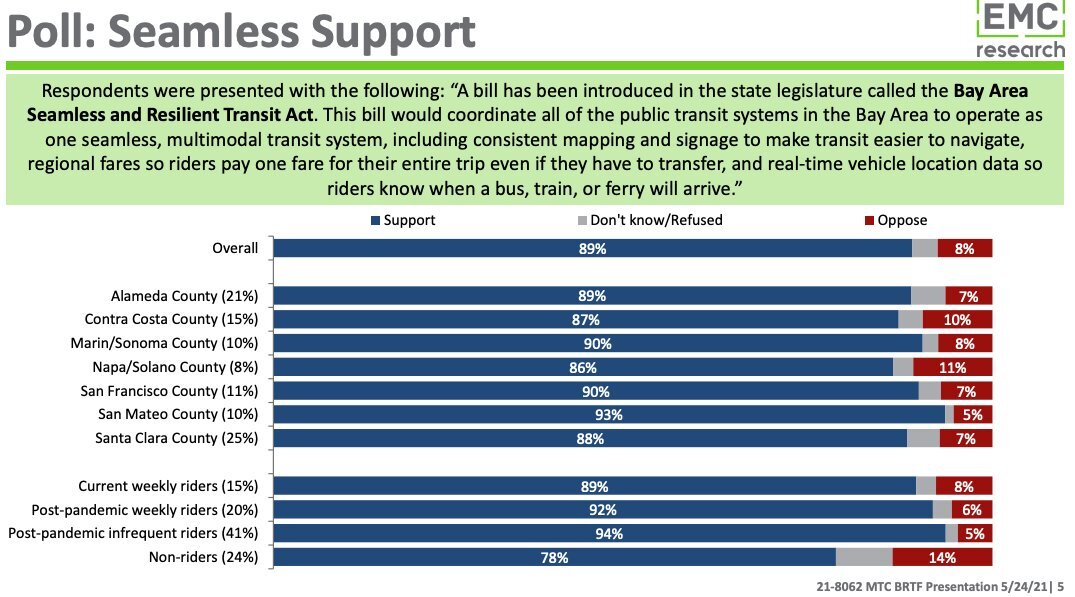An important conversation begins this Monday, December 13th from 2-4pm with an MTC Listening Session on a Regional Ballot Measure; it will be more important than ever for riders to speak up!
Twenty-one months into the COVID-19 pandemic, it might appear that public transit, like many aspects of life in the Bay Area, is settling into a “new normal.” While service isn’t as plentiful as it was pre-pandemic, BART is at least back to running trains until midnight again; Muni and AC Transit are running 75-85% of pre-pandemic service. While most buses and trains don’t come as often as they used to, some might conclude that maybe that’s not so bad - after all, people are commuting less, and working from home is likely to be more widespread in the future. Perhaps we just don’t need as much transit as we used to.
Unfortunately, despite the perception that public transit is “back,” it is very much operating on borrowed time in the Bay Area and is nowhere near approaching a new, sustainable normal. We have only been able to keep the reduced transit service we have thanks to one-time federal aid, which staved off catastrophic service cuts. Nearly every Bay Area transit agency is now approaching a ‘fiscal cliff’ when the federal dollars run out. The Bay Area’s largest transit agencies, BART and SFMTA, are each projecting annual shortfalls $250 million in 2024; Caltrain, AC Transit, and other agencies are in similarly challenging financial positions, facing a combination of very slow recovery of ridership, reduced local tax revenues, and increased costs.

A sustainable new source of operations funding for transit is urgently needed to avoid permanent service cuts at all our agencies. Service cuts would be devastating not only to the hundreds of thousands of Bay Area residents who rely on transit to get around, making many trips longer and sometimes even impossible. Cuts would also lead to permanent reductions in transit use, pushing anyone who has a choice to drive for all their needs. This would worsen congestion, which has already returned to pre-pandemic levels in many parts of the region and make meeting our transportation emissions reduction goals - which rely on attracting significantly more people to transit - virtually impossible.
To win back riders, transit agencies need to shift their services to rapidly adapt to changing travel patterns. Transit needs to be more time-competitive for all types of trips, not just commutes during rush hour towards downtowns. This means running more service throughout the day and focusing on seamless connectivity between services, with integrated fares, wayfinding, and schedules. Making these changes can ultimately make transit more efficient, but they won’t be easy; they’ll take time, money, unprecedented levels of collaboration - and the establishment of a Network Manager that enables the running of transit as a single network rather than a set of isolated services.
Two paths lie before us. The first - and the path of least resistance - would see each transit agency and county acting in isolation to try to shore up revenue to avoid painful service cuts. We would end up with multiple, overlapping ballot measures across the region to save individual agencies’ service in 2023-2024. San Francisco voters could face up to three separate transit ballot measures within 1 to 2 years: a BART ballot measure, a Caltrain measure, and an SFMTA measure. East Bay Voters may be faced with a BART measure and AC Transit measure, plus even an additional county measure, while Santa Clara County voters would potentially be faced with both Caltrain and VTA measures.

The alternate path is a coordinated, regional ballot measure for transit that is paired with reforms that restructure transit to be managed as a seamless integrated transit system. This path provides the best chance of both passing and providing the scale of investment needed to turn Bay Area transit around. A regional ballot measure will be far more likely to pass with the inclusion of seamless integration of service, branding, and fares. Polling conducted earlier this year by the Metropolitan Transportation Commission found that a remarkable 89% of Bay Area voters supported integrated fares, service, schedules, and wayfinding.
The stakes could not be higher for public transit right now. At MTC kicks off regional discussions about a potential future transportation ballot measure on December 13th with a Listening Session, the message from Bay Area transit riders must be clear: Pairing new funding from a coordinated regional ballot measure with governance reforms that will create a more seamless, efficient and rider-first system is the only viable path forward for our region.
—
Are you free to speak up in support of a major funding measure in 2024 to help prevent Bay Area transit from going off a cliff? Monday, December 13th between 2-4pm? Here’s the zoom link to make a public comment: https://bayareametro.zoom.us/j/86902151238.
***
Ian Griffiths is the Policy Director and Co-Founder of Seamless Bay Area, a non-profit advocating for an integrated, world-class transit system.






